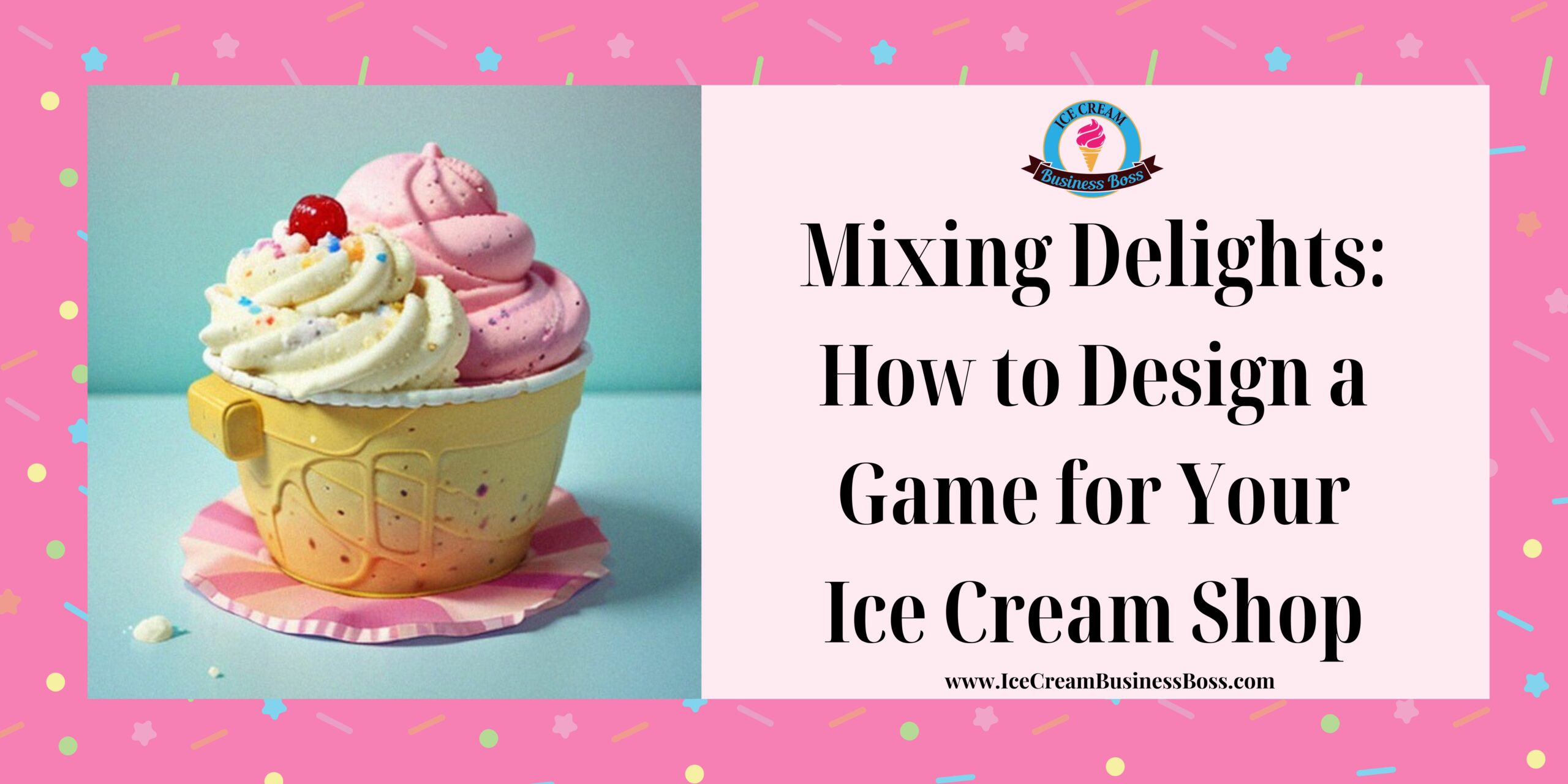Ice cream shops have always had a distinct position in the realm of frozen delights and sweet enjoyment. They are more than just venues to satiate our appetites for creamy sweets; they are places where we make memories and share joy. However, standing out in today’s competitive business market requires more than just excellent flavors. This is where the idea of creating an ice cream shop game comes into play.
To create and design a game in your ice cream shop, you should start by defining the game concept, setting objectives, and designing rules. Use simple materials like cards, tokens, or digital apps to engage customers. Ensure the game aligns with the ice cream shop’s theme and atmosphere to enhance the overall experience for patrons.
In this article, we’ll take a look at the interesting world of building games for an ice cream business. We’ll go into the creative process, practical issues, and the numerous ways these games may help your business.
Defining the Game Concept
It’s thrilling to create a game for your ice cream business, but before you get started, you must have a clear idea of what you want the game to be about. This fundamental stage creates the foundations for your clients to have a memorable and captivating experience. Several important factors are taken into account to do this.
Consider the makeup of your target audience first. It is crucial to comprehend their tastes and passions. Do you serve families looking for a calm, unhurried environment? Or is your clientele more drawn to a hectic, competitive environment? You may make the game more appealing to your audience by learning about their preferences.
Create a list of prospective game ideas that are in line with the preferences of your audience after you’ve gotten insight into their preferences. You might want to design a game that goes well with the calm mood your ice cream parlor produces, for example. To encourage visitors to savor and appreciate the subtleties of your ice cream products, consider developing something like a leisurely “Guess the Flavor” game or a crossword puzzle with an ice cream theme.
On the other hand, if your ice cream business serves a more competitive clientele, think about creating a game that gets people’s blood flowing. Maybe a competition to see who can construct the largest, most complex ice cream tower in the shortest amount of time. This not only ups the excitement level but also encourages friendly competition among clients.
You might also choose to take an educational approach by including a trivia game on interesting ice cream facts. This increases your consumers’ enthusiasm for the frozen treats you offer by entertaining and educating them. An appealing alternative would be to provide customers the chance to customize their special ice cream desserts by choosing from a variety of toppings and flavors.
Set a game’s objective in crystal clear terms. What do you hope your clients will remember about the encounter? Is the goal to promote relaxation and a sense of community? Is it to market your ice cream flavors and products? Outlining your aims in clear terms will direct the game’s creation and guarantee that it is consistent with your corporate goals.
Visit our article here to learn more on how to craft a great ice cream shop ambiance.
Setting Objectives

Establishing precise and well-defined game objectives is the most important stage after conceptualizing the idea for a game in your ice cream shop. The game’s development and execution are guided by its objectives, which also guarantee that it is perfectly in line with your overall business plan. These objectives in the field of game design for a company like an ice cream shop can include several targets and results.
Decide if boosting client involvement is your main goal. Engaging with clients in distinctive and enjoyable ways is a vital growth factor in today’s cutthroat industry. A well-designed game may hold customers’ interest and enhance their experience at your ice cream parlor. It can inspire interaction, foster a feeling of community, and entice clients to come back for more delightful delights.
Increasing sales is a crucial objective to take into account. A game that is purposefully made to advertise your ice cream flavors and goods might significantly affect your revenue. For instance, you may offer a game where players can complete objectives to gain bonuses like free toppings or discounts. This increases sales by encouraging more customer exploration of your menu options in addition to encouraging involvement.
On the other hand, if you discover that there are frequent lines at your ice cream business, especially during busy periods, your game can serve the goal of amusing and diverting customers while they wait for their orders. The improvement of the client experience is the main focus of this goal. Wait times can seem shorter and more pleasurable with the help of a well-made game, giving clients a favorable picture of your business.
Setting clear goals is crucial because they offer a quantifiable framework for gauging the effectiveness of your game. It enables you to monitor important performance indicators like improved client interaction, rising sales, or a decline in wait-time-related complaints. You may make data-driven tweaks to your game strategy and make sure it keeps achieving your business objectives by routinely tracking these indicators.
Clear goals also give your game development team or partners helpful direction. They may guide the creative process in a way that is consistent with your company’s goals. For instance, if increasing sales is the primary objective, the game might be created with elements that encourage product discovery and upselling potential.
Designing Rules

Rules are the foundation upon which the entire gaming experience is built in the world of game design for your ice cream shop. They act as the framework for establishing justice, consistency, and a sense of order, enabling both players and employees to enjoy the game. A critical step in guaranteeing the growth of your ice cream business game is creating a set of simple, understandable rules.
When creating game rules, simplicity is crucial in the first place. Customers of all ages should be able to play the game without becoming lost or confused. There shouldn’t be much jargon or complicated terminology, just clear, simple guidelines. Consider them the user guide for your game, and aim for simplicity and clarity.
Rules should take into account how long the game will last. Do you anticipate a quick, casual game that can be completed in a few minutes, or do you picture a more involved, prolonged experience? To manage expectations and keep players interested, specify the game’s beginning and finish points in clear terms. If you’re hosting a trivia contest about ice cream facts, for instance, be sure to include the number of questions or rounds as well as the allotted amount of time for each question.
Create a clear scoring structure that represents the goals of your game. The scoring system should be clear and simple to understand, whether it involves receiving points for answering questions correctly, finishing tasks, or attaining particular in-game objectives. As users want to raise their scores, this not only gives the game a competitive edge but also encourages recurring participation.
Your ice cream shop game can become more interesting and compelling by including special terms or bonuses. These could be extra rewards or pleasant surprises like power-ups, bonus games, or special challenges. To ensure that players understand how to activate these special components and the advantages they provide, it’s imperative to properly define them in your rules. This makes the game more strategic and improves the entire experience.
A variety of difficulty settings or personalization options could help your game appeal to a wide range of players. Due to the ability to select their level of difficulty, players of different skill levels can participate in and enjoy the game.
Review and improve your game’s rules frequently in light of player comments and observations. This iterative method guarantees that the rules stay approachable and interesting while adjusting to the audience’s shifting preferences for your ice cream shop.
Check out this article to learn more about designing your small ice cream shop business.
Choosing Materials
Making the appropriate choices for your ice cream shop game’s components is crucial since they can have a big impact on how well it plays and how well it resonates with players. Several considerations, like your target audience, your budget, and the atmosphere you want to create inside your ice cream store, will determine whether you choose to use conventional game materials or contemporary technology, including digital app-based games.
Cards, dice, and other traditional game components like tokens have a timeless allure. They evoke feelings of familiarity and can make your ice cream business feel warm and inviting. Many clients, particularly families and those looking for a traditional, vintage vibe, may find this tactile experience provided by these actual components to be endearing and captivating. A tangible component can be added to the gaming experience by rolling the dice, drawing cards, or moving tokens around a game board, which can improve enjoyment.
Traditional game materials can also be inexpensive, making them a good option for companies on a tight budget. They are reusable and need no upkeep, making them a sustainable choice for your ice cream shop’s long-term usage.
On the other hand, utilizing contemporary technology and creating an app-based game gives a unique set of benefits. Modern video games are renowned for their portability and flexibility. Customers no longer require actual components because they can readily access and play these games on their smartphones or tablets. Younger audiences that are used to digital interactions and tech-savvy people may find this to be particularly appealing.
Dynamic and interactive gameplay is possible with digital games, which makes it simpler to add new features, difficulties, and upgrades. You can make your game more competitive and engaging by adding features like leaderboards, achievements, and real-time multiplayer. You may track player preferences and behavior with the use of significant data insights from digital games.
The decision between traditional and digital materials ultimately comes down to your ice cream shop’s target market and the atmosphere you want to establish. classic gaming materials might be the perfect choice for your store if it has a nostalgic, classic vibe, enhancing the allure of your business. Digital app-based games, on the other hand, can be the best option if you want to appeal to a tech-savvy, quick-moving audience or want to provide a more involved and constantly growing gaming experience.
Aligning with the Shop’s Theme

Making an effective ice cream store game requires careful consideration of integration with the theme and ambiance of your shop in addition to rules and materials. The game must harmoniously complement the colors, design, and general brand identification of your ice cream parlor for it to properly connect with your customers. Due to the careful attention to detail, the game becomes a natural and engaging element of the ice cream store experience, boosting the atmosphere and leaving customers with a memorable impression.
Color coordination is one of the first things to take into account in this regard. Your ice cream shop game’s colors should complement the hues utilized in your store’s decor and branding. For instance, using these hues in the game’s graphics and elements can generate visual consistency if your ice cream shop has a lively and joyful color scheme with pastel pink and turquoise tones. This not only strengthens your brand identification but also makes it easier for the game to fit in with the surroundings of the store.
Similar to this, the design and aesthetics of the game ought to go well with the ice cream shop as a whole. Incorporating items like diner booth-shaped gaming boards or vintage-style drawings into your shop’s throwback, 1950s diner concept can improve the immersive experience. On the other hand, choosing slick and current game design components can keep your brand image consistent if your ice cream business emanates a modern and minimalist vibe.
The use of logos and branding within the game is consistent. Reinforcing brand familiarity is accomplished by including your ice cream shop’s logo or mascot in the game materials, such as game cards or digital app interfaces. This not only advertises your company but also gives your clients a feeling of familiarity.
When designing game elements, keep in mind the overall theme and tone of your ice cream shop. If the ambiance at your store is meant to be welcoming to families and wholesome, make sure the game reflects these ideals. Incorporate elements of fun and edginess into the game’s aesthetics and images, on the other hand, if your store caters to a younger, trendier clientele.
The ultimate objective is to create a sense that the game is an essential component of the ice cream shop experience. Customers should be welcomed by a setting where every element—including the game—contributes to the atmosphere as soon as they enter your business. Customers are more engaged and make lasting memories thanks to this immersive approach, which also makes them want to come back for more ice cream and gaming fun.
Frequently Asked Questions
What kinds of games work best in an ice cream shop?
Ice cream store games frequently feature a light and pleasant vibe. Popular options include trivia games with ice cream-related questions, customization challenges in which customers design their sundaes, and basic board games. The type of game should correspond to the topic of your shop and cater to your target demographic.
Does creating a game necessitate the use of digital technology, or may I utilize conventional materials?
Your preferences and money will determine whether you use digital or conventional materials. Both strategies have the potential to be beneficial. Cards, dice, and tokens can provide a nostalgic and tactile experience, whilst digital apps bring ease and variety. When making this decision, consider your target audience as well as the general feel of your ice cream shop.
How can I publicize the game at my ice cream shop?
The game’s growth is dependent on its promotion. To spread the word about the game, use various marketing methods such as social media, in-store signage, and word-of-mouth. To promote participation, consider providing incentives like as discounts or complimentary toppings to game winners. To generate excitement and encourage repeat visits, engage your customers by broadcasting game updates and winners on social media.
The information provided by IceCreamBusinessBoss.com (“The Site”) is for general informational purposes only. All information on the Site is provided in good faith, however, we make no representation or warranty of any kind, express or implied, regarding the accuracy, adequacy, validity, reliability, availability, or completeness of any information on the Site. Under no circumstance shall we have any liability to you for any loss or damage of any kind incurred as a result of the use of the Site or Reliance on any information provided on the Site. Your use of the Site and your reliance on any information on the Site is solely at your own risk. This blog post is for educational purposes only and does not constitute legal advice. Please consult a legal expert to address your specific needs. Terms and Conditions.

Hi! I am Shawn and I am a happy individual who happens to be an entrepreneur. I have owned several types of businesses in my life from a coffee shop to an import and export business to an online review business plus a few more and now I create online ice cream/gelato business resources for those interested in starting new ventures. It’s demanding work but I love it. I do it for those passionate about their business and their goals. That’s why when I meet a ice cream/gelato business owner, I see myself. I know how hard the struggle is to retain clients, find good employees and keep the business growing all while trying to stay competitive.
That’s why I created Ice Cream Business Boss: I want to help ice cream and gelato business owners like you build a thriving business that brings you endless joy and supports your ideal lifestyle.

